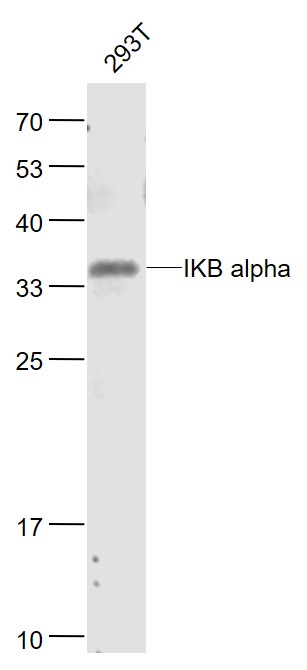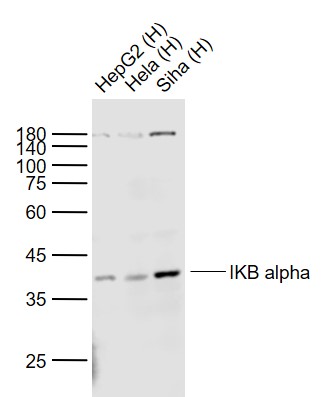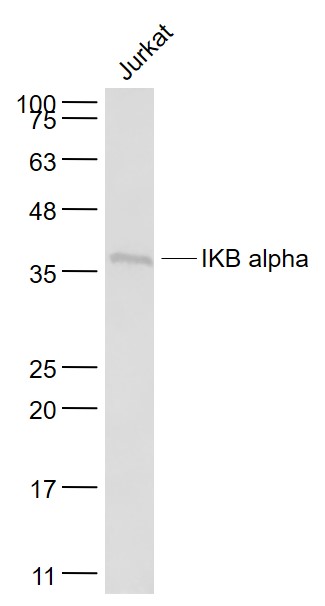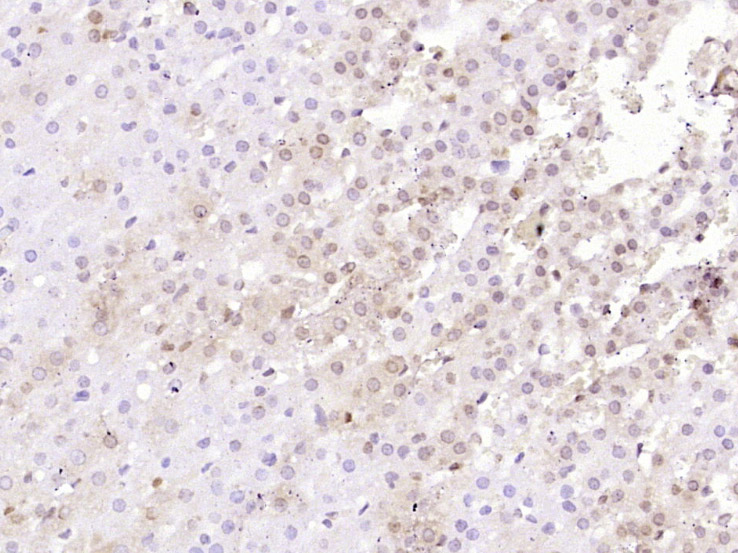
Mouse Anti-IKB alpha antibody
NFKBIA; Inhibitor of KB alpha; I kappa B alpha; I(Kappa)B(alpha); IkappaBalpha; IKBA; IKBalpha; MAD 3; MAD3; Major histocompatibility complex enhancer binding protein MAD3; NF kappa B inhibitor alpha; NFKBI; NFKBIA; Nuclear factor of kappa light chain gen
View History [Clear]
Details
Product Name IKB alpha Chinese Name 核因子κB抑制蛋白α单克隆抗体 Alias NFKBIA; Inhibitor of KB alpha; I kappa B alpha; I(Kappa)B(alpha); IkappaBalpha; IKBA; IKBalpha; MAD 3; MAD3; Major histocompatibility complex enhancer binding protein MAD3; NF kappa B inhibitor alpha; NFKBI; NFKBIA; Nuclear factor of kappa light chain gene enhancer in B cells; Nuclear factor of kappa light polypeptide gene enhancer in B cells inhibitor alpha; IKBA_HUMAN. literatures Research Area Tumour immunology Signal transduction transcriptional regulatory factor Kinases and Phosphatases Immunogen Species Mouse Clonality Monoclonal Clone NO. 2A5 React Species Human, Rat, (predicted: Mouse, ) Applications WB=1:500-2000 IHC-P=1:100-500 IHC-F=1:100-500 ICC=1:100-500 IF=1:100-500 (Paraffin sections need antigen repair)
not yet tested in other applications.
optimal dilutions/concentrations should be determined by the end user.Theoretical molecular weight 36kDa Cellular localization The nucleus cytoplasmic Form Liquid Concentration 1mg/ml immunogen Recombinant human IKB alpha Protein: 1-77/314 Lsotype IgG1 Purification affinity purified by Protein A Buffer Solution 0.01M TBS(pH7.4) with 1% BSA, 0.03% Proclin300 and 50% Glycerol. Storage Shipped at 4℃. Store at -20 °C for one year. Avoid repeated freeze/thaw cycles. Attention This product as supplied is intended for research use only, not for use in human, therapeutic or diagnostic applications. PubMed PubMed Product Detail Three major forms of IKB like molecules have been identified and each is characterised by multiple copies of ankyrin repeats. IKB alpha and IKB beta appear to be the major regulatory forms of IKB in most cells. These proteins interact with p65 or cRel containing forms of NFkB and block nuclear import by masking the nuclear localisation sequences of NFkB. The activation of NFkB involves the inducible phosphorylation and subsequent degradation of IKB. Immunoblotting easily detects the hyperphosphorylated forms of IKB alpha, but not phosphorylated IKB beta. Interestingly, IKB alpha and IKB beta mediate different NFkB responses. IkB alpha appears to control more transient activation of NFkB in response to an inducer, while IKB beta controls a persistent response. Bcl3 interacts with p50 and p52 containing forms of NFkB, but rather than being an inhibitor it appears to function to stimulate transcription. The degradation of IKB is confirmed by immunoblotting.
Function:
Inhibits the activity of dimeric NF-kappa-B/REL complexes by trapping REL dimers in the cytoplasm through masking of their nuclear localization signals. On cellular stimulation by immune and proinflammatory responses, becomes phosphorylated promoting ubiquitination and degradation, enabling the dimeric RELA to translocate to the nucleus and activate transcription.
Subunit:
Interacts with RELA; the interaction requires the nuclear import signal. Interacts with NKIRAS1 and NKIRAS2. Part of a 70-90 kDa complex at least consisting of CHUK, IKBKB, NFKBIA, RELA, IKBKAP and MAP3K14. Interacts with HBV protein X. Interacts with RWDD3; the interaction enhances sumoylation. Interacts (when phosphorylated at the 2 serine residues in the destruction motif D-S-G-X(2,3,4)-S) with BTRC. Associates with the SCF(BTRC) complex, composed of SKP1, CUL1 and BTRC; the association is mediated via interaction with BTRC. Part of a SCF(BTRC)-like complex lacking CUL1, which is associated with RELA; RELA interacts directly with NFKBIA. Interacts with PRMT2. Interacts with PRKACA in platelets; this interaction is disrupted by thrombin and collagen. Interacts with HIF1AN.
Subcellular Location:
Cytoplasm. Nucleus.
Tissue Specificity:
Highly expressed in lymph node, thymus followed by liver, brain, muscle, kidney, gastrointestinal and reproductive tract.
Post-translational modifications:
Phosphorylated; disables inhibition of NF-kappa-B DNA-binding activity.
Phosphorylation at positions 32 and 36 is prerequisite to recognition by UBE2D3 leading to polyubiquitination and subsequent degradation.
Sumoylated; sumoylation requires the presence of the nuclear import signal. Monoubiquitinated at Lys-21 and/or Lys-22 by UBE2D3. Ubiquitin chain elongation is then performed by CDC34 in cooperation with the SCF(FBXW11) E3 ligase complex, building ubiquitin chains from the UBE2D3-primed NFKBIA-linked ubiquitin. The resulting polyubiquitination leads to protein degradation. Also ubiquitinated by SCF(BTRC) following stimulus-dependent phosphorylation at Ser-32 and Ser-36.
Deubiquitinated by porcine reproductive and respiratory syndrome virus Nsp2 protein, which thereby interferes with NFKBIA degradation and impairs subsequent NF-kappa-B activation.
DISEASE:
Defects in NFKBIA are the cause of ectodermal dysplasia anhidrotic with T-cell immunodeficiency autosomal dominant (ADEDAID) [MIM:612132]. Ectodermal dysplasia defines a heterogeneous group of disorders due to abnormal development of two or more ectodermal structures. ADEDAID is an ectodermal dysplasia associated with decreased production of pro-inflammatory cytokines and certain interferons, rendering patients susceptible to infection.
Similarity:
Belongs to the NF-kappa-B inhibitor family.
Contains 5 ANK repeats.
SWISS:
P25963
Gene ID:
4792
Database links:Entrez Gene: 4792 Human
Entrez Gene: 18035 Mouse
Omim: 164008 Human
SwissProt: P25963 Human
SwissProt: Q9Z1E3 Mouse
Unigene: 81328 Human
Unigene: 170515 Mouse
Unigene: 12550 Rat
Product Picture
293T(Human) Cell Lysate at 30 ug
Primary: Anti- IKB alpha (SLM-33441M) at 1/1000 dilution
Secondary: IRDye800CW Goat Anti-Mouse IgG at 1/20000 dilution
Predicted band size: 36 kD
Observed band size: 36 kD
Sample:
Lane 1: HepG2 (Human) Cell Lysate at 30 ug
Lane 2: Hela (Human) Cell Lysate at 30 ug
Lane 3: Siha (Human) Cell Lysate at 30 ug
Primary: Anti-IKB alpha (SLM-33441M) at 1/1000 dilution
Secondary: IRDye800CW Goat Anti-Mouse IgG at 1/20000 dilution
Predicted band size: 39 kD
Observed band size: 39 kD
Sample:
Jurkat(Human) Cell Lysate at 30 ug
Primary: Anti- IKB alpha (SLM-33441M) at 1/1000 dilution
Secondary: IRDye800CW Goat Anti-Mouse IgG at 1/20000 dilution
Predicted band size: 36 kD
Observed band size: 36 kD
Paraformaldehyde-fixed, paraffin embedded (Rat adrenal gland); Antigen retrieval by boiling in sodium citrate buffer (pH6.0) for 15min; Block endogenous peroxidase by 3% hydrogen peroxide for 20 minutes; Blocking buffer (normal goat serum) at 37°C for 30min; Antibody incubation with (IKB alpha) Monoclonal Antibody, Unconjugated (SLM-33441M) at 1:800 overnight at 4°C, followed by operating according to SP Kit(Mouse) (sp-0024) instructions and DAB staining.
References (0)
No References
Bought notes(bought amounts latest0)
No one bought this product
User Comment(Total0User Comment Num)
- No comment






 +86 571 56623320
+86 571 56623320
 +86 18668110335
+86 18668110335

